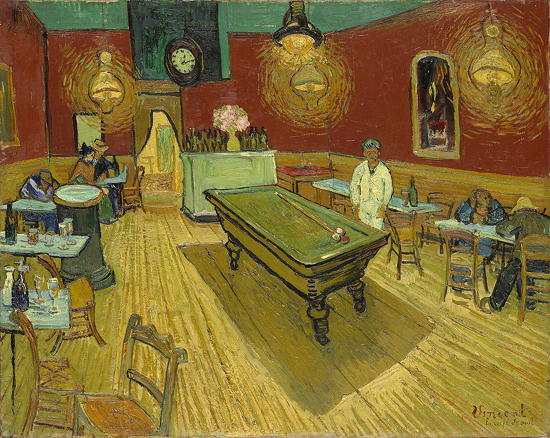Saturday, February 27th, 2010
Van Gogh News!
 What immediately comes to your mind when you think of paintings by Van Gogh? Sunflowers? Starry nights? Creepy self portraits with bandages that cover up a mutilated ear? Well, my friends, it looks like you can add new subject matter to Van Gogh’s oeuvre: a windmill and tricoleur flag. This painting on the right, Le Blute-Fin Mill (1886) was recently authenticated as a Van Gogh painting. Honestly, I never would have considered this to be by Van Gogh, mostly because of the human figures: not only are the uncharacteristically large, but there are a lot more bodies than you normally see in Van Gogh’s work. But I really like the use of color, and that does remind me of Van Gogh. I especially like the red highlights of the woman’s dress in the foreground. What do you think? Do you like this painting?
What immediately comes to your mind when you think of paintings by Van Gogh? Sunflowers? Starry nights? Creepy self portraits with bandages that cover up a mutilated ear? Well, my friends, it looks like you can add new subject matter to Van Gogh’s oeuvre: a windmill and tricoleur flag. This painting on the right, Le Blute-Fin Mill (1886) was recently authenticated as a Van Gogh painting. Honestly, I never would have considered this to be by Van Gogh, mostly because of the human figures: not only are the uncharacteristically large, but there are a lot more bodies than you normally see in Van Gogh’s work. But I really like the use of color, and that does remind me of Van Gogh. I especially like the red highlights of the woman’s dress in the foreground. What do you think? Do you like this painting?
This authentication is pretty exciting – Le Blute-Fin Mill is the first Van Gogh to be authenticated since 1995. However, admittedly, the painting has long been disputed as by Van Gogh – an eccentric art collector bought the painting and always claimed it to be by the master, but no one took the collector seriously. You can read more about the story and authentication here.
 In other Van Gogh news, the famous The Night Cafe (1888, shown left) is involved in a dispute regarding ownership. This painting has hung for almost fifty years in the Yale University Art Gallery, but now Pierre Konowaloff, the great-grandson of the previous owner, is trying to claim the painting back. It seems like a pretty sticky situation: Konowaloff’s great-grandfather bought the painting in 1908, but it was subsequently nationalized and sold by the Soviet government during the Russian Revolution. Therefore, Konowaloff believes that the painting classifies as “stolen” and feels justified in claiming it back.
In other Van Gogh news, the famous The Night Cafe (1888, shown left) is involved in a dispute regarding ownership. This painting has hung for almost fifty years in the Yale University Art Gallery, but now Pierre Konowaloff, the great-grandson of the previous owner, is trying to claim the painting back. It seems like a pretty sticky situation: Konowaloff’s great-grandfather bought the painting in 1908, but it was subsequently nationalized and sold by the Soviet government during the Russian Revolution. Therefore, Konowaloff believes that the painting classifies as “stolen” and feels justified in claiming it back.
I personally don’t think that Konowaloff has a very good chance of getting The Night Cafe back, but what do other people think?
It is a very interesting painting, that seems to sit in-between his dark, brown, Dutch paintings (of which there is a good example – or two? – at the Fitzwilliam Museum in Cambridge) and his colourful work from France. The red(s) serve to unite the different planes and Van Gogh is still somehow using a sort of atmospheric perspective (compare the red of the TWO tricolore/tricolour with the foreground dress).
The characters are uncharacteristically large, numerous (as you mentioned) and central: there are some characters in the night café picture, but they are on the side…
Thanks for sharing! & thanks for your blog. I wish I could find more art history blogs.
http://davidikus.blogspot.com/
I actually really love the windmill picture. The reds with all the dark tones really does it for me! As far as the disputed ownership goes I think "stolen" is not the correct term, maybe "forcibly taken", but either way I'm thinkin' the poor guy will just have to do without.
That is a very atypical Van Gogh painting–to me it looks more like a Manet. Maybe he went through a Manet phase? 🙂
As for Yale's Night Cafe, I've heard about that dispute. I don't think Konowaloff has much of a case, either, but I'm not an expert on these things. Has any museum been forced to return art under similar circumstances?
I think this is such a great story. Ever since your lost Rembrandt post, I get such a thrill out of rediscovered, long lost pieces of art. And I think it is a very cool painting. I like the colors. I'll bet it is really stunning in person.
Those red highlights popped out to me as well – and those along with the railing lead your eye up the stairs, to the windmill, then to the flag on top. Very interesting painting. I wouldn't have thought it to be a Van Gogh either.
I just died laughing at your description of his self portraits.